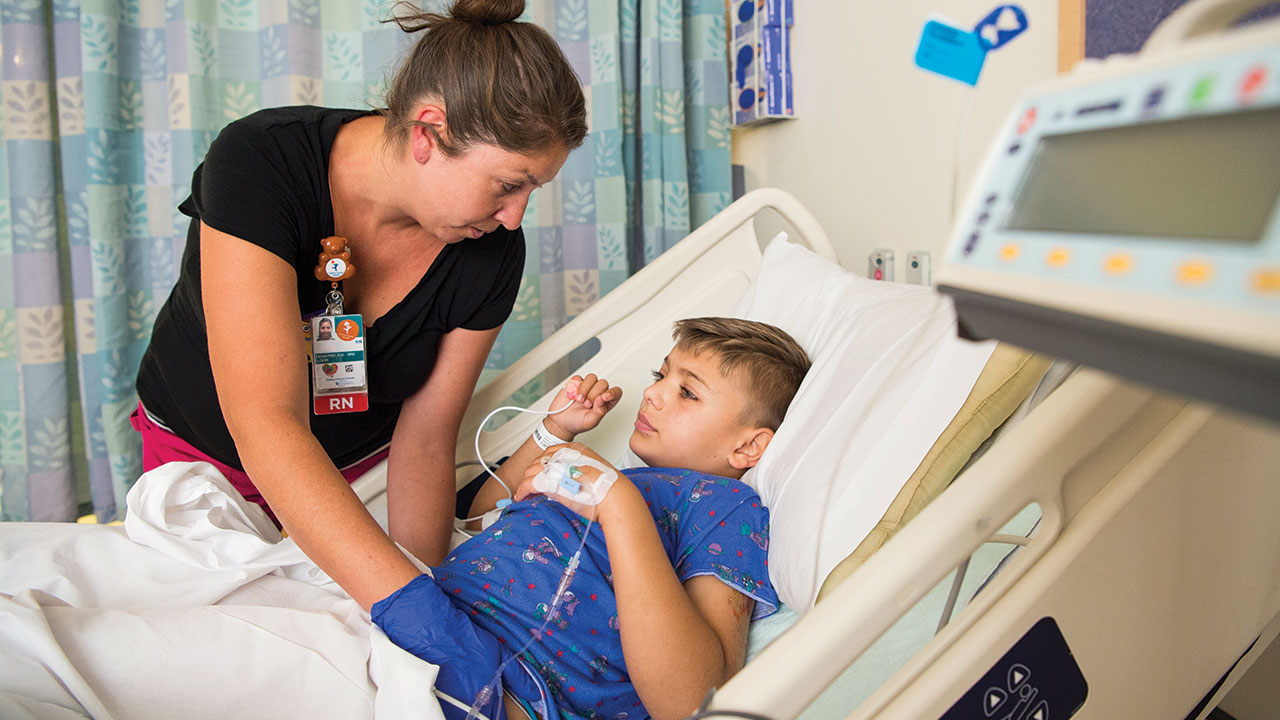Intravenous nutrition saves lives. Used long-term, though, it's also connected to cirrhosis and eventual liver failure. "We didn't know what caused it, how to treat it, or how to prevent the disease from progressing," says Ronald Sokol, MD, Chief of Pediatric Gastroenterology, Hepatology and Nutrition at Children's Colorado. "Without a way to chronicle the pathogenesis of the disease, we were stuck."
Until the advent of total parenteral (intravenous) nutrition, or TPN, a half century ago, patients with necrotizing enterocolitis, short bowel syndrome and other gastrointestinal malformations would not survive. While TPN increased survival and quality of life for many, physicians soon realized that long-term treatment came with grave side effects for infants and children with bowel problems, the most serious among them rapidly-progressing cirrhosis and liver failure. Often fatal without a liver or multivisceral transplant, this intestinal failure associated liver disease (IFALD), also called TPN-associated cholestasis (PNAC), was a major stumbling block for the field.
Seeing the toll it took on these young patients, Dr. Sokol, gut macrophage expert Karim El Kasmi, MD, and a team of researchers from Children's Colorado and the University of Colorado School of Medicine set out to develop an animal model, one that would replicate the human pathophysiology of parenteral nutrition-associated cholestasis in infants and allow researchers to develop and test new treatments.
Forming a hypothesis about TPN-associated cholestasis
"We hypothesized that intestinal injury was just as important as the application of TPN," says Dr. Sokol. "We speculated that the lack of enteral feeding may significantly reduce intestinal motility and favor bacterial overgrowth, subsequently aggravating underlying inflammation. This, together with the presumed increased intestinal permeability of infants, could compromise the intestinal barrier function."
With a poorly functioning intestinal barrier, bacterial proteins, lipids or nucleic acids could be entering the portal vein, they surmised, initiating inflammatory pathways in the liver and activating receptor signaling, thereby promoting injury to the liver cell along with cholestasis, cell death and necrosis. But this alone was not enough to explain the damage done to the liver. They also proposed that there was something in the intravenous nutrition that synergized with the intestinal failure to cause liver injury.
To study this phenomenon, they developed a mouse model to induce intestinal injury and increased permeability using dextran sulphate sodium (DSS) followed by a continuous infusion of soy-based lipid parenteral nutrition through a central venous catheter. They found that they could cause cholestasis and liver injury, but only with the combination of both intestinal injury and TPN infusion.
"We believed that we could dramatically improve treatments, but only if we could understand the mechanism of the injury occurring in the liver."
- RONALD SOKOL, MD
The role of lipids in PNAC
The team of researchers then used their model to demonstrate the part played by TPN, combining evidence coming out of other research centers to prove that the lipid component of TPN — plant sterols in particular — was a major factor responsible for PNAC.
Around the same time, other physicians were taking different approaches: reducing the lipids in TPN, switching to fish oil-based IV lipids and using a newer preparation called SMOF – a combination of soy, fish and other oils.
"Lipid modification discovered in Boston was a big breakthrough, and our model verifies that modifying lipids from soy-based emulsions to fish oil-based emulsions, or reducing the lipid amount, is a good thing for the liver. There's a clear link but we believe that we can improve treatment even further, without reducing the amount of brain-building lipids that infants receive," says Dr. Sokol.
By now, Dr. Sokol and his team of physician scientists were narrowing in on the role of hepatic macrophages, which they hypothesized may be triggered by plant sterol containing lipid emulsions and gut-derived products to release cytokines that directly suppress bile and sterol transporters in the liver, causing cholestasis. If they could further understand the mechanism of the injury, there could be other therapies that would still allow infants to get all the lipids they need.
For that, they combined genetic, molecular and pharmacological approaches to distill the role of the signaling pathways that control bile transporter proteins. More experiments showed that these pathways could be activated to make more bile transporters by using new drugs coming out on the market.
A path forward: drugs to prevent PNAC

The model of PNAC pathogenesis: This figure shows how increased intestinal permeability leads to absorption of LPS into the portal vein with subsequent TLR4-mediated activation and generation of IL-1β in recruited liver macrophages; phytosterols also contribute to macrophage activation. IL-1β then activates NF-κβ in the hepatocytes, which interferes with LXR and FXR binding to genes that lead to lower BSEP, MRP2, and ABCG5/8 in hepatocytes and bile acid and phytosterol retention. Retained phytosterols reduce FXR activity further with reduced BSEP and MRP2 causing further retention of bile acids that cause cholestatic injury.
Since their successful modeling, Sokol and team have narrowed in on potential targets — hepatic macrophages, IL-1β, NF-κB or FXR — for restoring bile and sterol transport as novel ways to treat PNALD. Their latest research with the complete hypothetical model of PNAC pathogenesis was published in Nature Communications in Jan. 2018.
"If we can interfere with one of these pathways and prevent PNAC, it could dramatically alter the course of treatment for these infants and children, allow them to receive enough IV lipids and prevent the need for multivisceral transplants," Dr. Sokol says. "This isn't a cure, but it certainly is a game-changer."
Featured Researchers

Ronald Sokol, MD
Chief Scientific Officer, Child Health
Digestive Health Institute
Children's Hospital Colorado
Director, Colorado Clinical and Translational Sciences Institute
University of Colorado School of Medicine
Karim El Kasmi, MD
Assistant professor
Pediatrics
University of Colorado School of Medicine





 720-777-0123
720-777-0123










